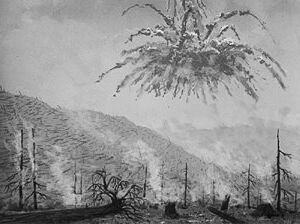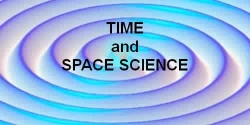Tunguska Event - Siberia 1908
Tunguska Event - Siberia 1908
The 1908 Tunguska Explosion: Atmospheric Disruption of a Stony Meteorite

At 1000km
At 500km
At 400km
At 200km
At 170km
At 30km
Eye witness accounts
Evidence of atmospheric explosion
Extent of damage
Could it happen again?
For more information
see also Identifying
Meteorites...
see also Meteorite Minerals...
see also Meteorites...
At 7:17 AM on the morning of June 30, 1908, a mysterious explosion occurred in the skies over Tungusta, Siberia. It was caused by the impact and breakup of a large meteorite, at an altitude roughly six kilometers in the atmosphere.

At 1000km
You can get a sense of the magnitude of this event by comparing
observations made at different distances. Seismic vibrations were recorded
by sensitive instruments as much as 1000 km away. At 500km
At 500 km , observers reported "deafening bangs" and a fiery cloud on the
horizon. At 400km
After this object passed across the sky, it approached the horizon where it was consistently described from this distance of 400 km, as appearing like a "pillar of fire," then replaced by "a cloud of smoke rising from the ground," or "a cloud of ash...on the horizon," or "a huge cloud of black smoke.At 200km
"From a closer distance of around 200 km, several witnesses gave a better description of the object itself. It was called diffuse bright ball two or three times larger than the sun but not as bright; the t rail was a "fiery-white band." Inconsistent colors were mentioned: white, red, flame-like, bluish-white. Perhaps it had a flame-like iridescence.At 170km
About 170 km from the explosion, the object was seen in the cloudless, daytime sky as a brilliant, sunlike fireball; thunderous noises were heard. At distances around 60 km, people were thrown to the ground or even knocked unconscious; windows were broken and crockery knocked off shelves.At 30km
Probably the closest observers were some reindeer herders asleep in their tents in several camps about 30 km from the site. They were blown into the air and knocked unconscious; one man blown into a tree later died. "Everything around was shrouded in smoke and fog from the burning fallen trees."
"Early in the morning when everyone was asleep in the tent, it was blown up in the air along with its occupants. Some lost consciousness. When they regained consciousness, they heard a great deal of noise and saw the forest burning around them, much of it devastated." "The ground shook and incredibly prolonged roaring was heard. Everything round about was shrouded in smoke and fog from burning, falling trees. Eventually the noise died away and the wind dropped, but the forest went on burning. Many reindeer rushed aw ay and were lost."One older man at about this distance was reportedly blown about 12-15m into a tree, causing a compound fracture of his arm, and he soon died. Hundreds of the herders' reindeer, in the general area around ground zero, were killed. Many campsites and storage huts scattered in the area were destroyed.

Eye witness accounts
Witnesses in the town of Kirensk and nearby towns at the same distance recollected the fireball flashing across the sky in the following terms:"A ball of fire...coming down obliquely. A few minutes later [we heard] separate deafening crash like peals of thunder...followed by eight loud bangs like gunshots." "A ball of fire appeared in the sky... As it approached the ground, it took on a flattened shape..."
"A flying star with a fiery tail; its tail disappeared into the air."
"I was sitting on the porch of the house at the trading station, looking north. Suddenly in the north...the sky was split in two, and high above the forest the whole northern part of the sky appeared covered with fire. I felt a great heat, as if my shir t had caught fire... At that moment there was a bang in the sky, and a mighty crash... I was thrown twenty feet from the porch and lost consciousness for a moment.... The crash was followed by a noise like stones falling from the sky, or guns firing. The earth trembled.... At the moment when the sky opened, a hot wind, as if from a cannon, blew past the huts from the north. It damaged the onion plants. Later, we found that many panes in the windows had been blown out and the iron hasp in the barn door had been broken."
"I saw the sky in the north open to the ground and fire poured out. The fire was brighter than the sun. We were terrified, but the sky closed again and immediately afterward, bangs like gunshots were heard. We thought stones were falling... I ran with my head down and covered, because I was afraid stones my fall on it."
Evidence of atmospheric explosion
The meteorite did not strike the ground or make a crater, early researchers thought the object might be a weak, icy fragment of a comet, which vaporized explosively in the air, and left no residue on the ground. However, modern planetary scientists have much better tools for understanding meteorite explosion in the atmosphere. As a meteorite slams into the atmosphere at speeds around 12 to 20 km/sec or more, itexperiences a strong mechanical shock, like a diver bellyflopping into water. This can break apart stones of a certain size range, which explode instead of hitting the ground. Some of them drop brick-sized fragments on the ground, but others, such as the one that hit Siberia, may produce primarily a fireball and cloud of fine dust and tiny fragments. In 1993 researchers Chris Chyba, Paul Thomas, and Kevin Zahnle studied the Siberian explosion and concluded it was of this type -- a stone meteorite that exploded in the atmosphere. This conclusion was supported when Russian research ers found tiny stoney particles embedded in the trees at the collision site, matching the composition of common stone meteorites. The original asteroid fragment may have been roughly 50-60 meters in diameter.Extent of Damage
The effect on the ground was limited to devastation of a large forest areas. At ground zero, tree branches were stripped, leaving trunks standing up. But at distances from roughly 5 out to 15km, the trees were blown over, lying with tops pointed away from the blasts.
Could it happen again?
Many asteroidal fragments circle the Sun; the Siberian object was merely the largest to hit the Earth in the last century or so. Had it hit a populated area, devastation would have been enormous. If there are many asteroid fragments, why don't we see mo re hits? We do! The problem is that they have not been understood until recently. Current studies reveal that such explosions may happen every couple of centuries; however, six out of seven happen over the ocean, and few happen over populated land. A key to the phenomenon is: the larger the impact the rarer it is. An Air Force satellite in the 1990s detected a smaller explosion over the Pacific. In 1972, a 1000-ton object skimmed tangentially through Earth's atmosphere over the Grand Tetons in Wy oming, and then skipped back out into space, like a stone skipping off water. It was photographed by tourists and detected by Air Force satellites. Had it continued on into the atmosphere, it could have caused a Hiroshima-scale explosion over Canada, so mewhat smaller than the Siberian blast. Even larger objects have hit Earth, but they are more rare. For example, an iron asteroid fragment perhaps 100 m across hit Arizona about 20,000 years ago, leaving the kilometer-wide "Arizona Meteor Crater," which i s open to visitors; and a 10-km asteroid hit Earth 65 million years ago, ending the reign of dinosaurs. Brick-sized interplanetary stones fall from the sky in various locations every year. Several houses and a car have been hit in recent decades. Tiny dust grains are even more common; they can be seen every night if you watch long enough; they are the bright streaks of light sometimes called "shooting stars." Interplanetary space contains many small bodies of different sizes. All of them move in ell iptical orbits around the sun as prescribed by Kepler. Occasionally their orbits intersect those of planets, leading to a collision. Large enough bodies leave sizable planets or satellites. This explains why impact craters are present on surfaces of p lanets and moons throughout the solar system. If we continue to study asteroids and build more telescopes for detecting and tracking them, we will have better information about the frequency of such asteroid impact-explosions, and more chance to have warn ing about impending impacts.
For more information
Chyba, C., P. Thomas, and K. Zahnle 1993. "The 1908 Tunguska Explosion: Atmospheric Disruption of a Stony Asteroid". Nature 361, p. 40-44. (Calculation of size of the bolide.)Gallant, Roy A. 1994 "Journey to Tunguska". Sky and Telescope, June, 38-43. (Description of a modern journey to the site, with photographs.)
Krinov, E. L. 1966 Giant Meteorites (London: Pergamon Press). (Description of the site and interviews with witnesses).

